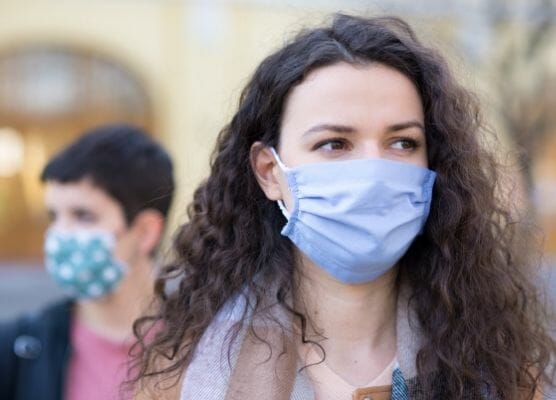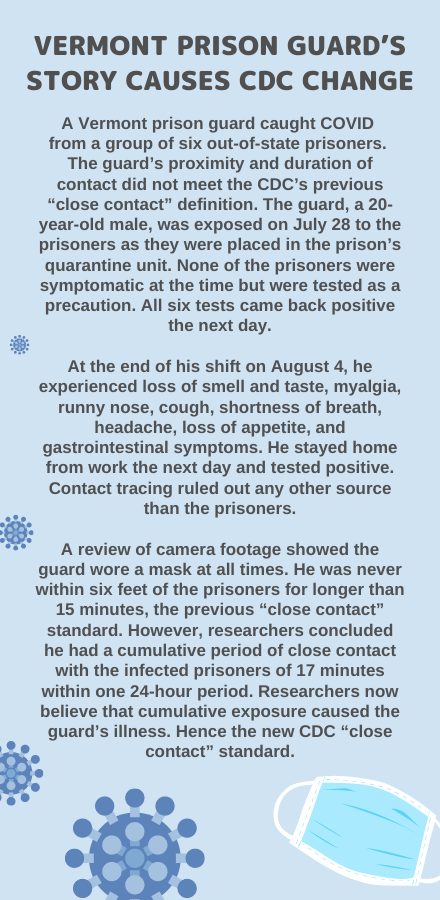New CDC guidelines affect return to work plans
 New Centers for Disease Control (CDC) guidelines offer an updated definition of “close contact.” The change may seem minor, but it will have a large impact on employer’s reopening plans. Employers should incorporate this latest guidance into their reopening plans.
New Centers for Disease Control (CDC) guidelines offer an updated definition of “close contact.” The change may seem minor, but it will have a large impact on employer’s reopening plans. Employers should incorporate this latest guidance into their reopening plans.
Close contact
The CDC now defines a close contact as “Someone who was within 6 feet of an infected person for a cumulative total of 15 minutes or more over a 24-hour period starting from 2 days before illness onset (or, for asymptomatic patients, 2 days prior to test specimen collection) until the time the patient is isolated.”
This could mean three periods of five minutes within a 24-hour period, or any combination that totals at least fifteen minutes. Because the contacts are tracked in 24-hour periods, they could occur on different consecutive days.
For employers, the “close contact” definition comes into play when tracing contacts in the workplace. The CDC recommends employers also consider factors such as:
- proximity (closer distance likely increases exposure risk),
- the duration of exposure (longer exposure time likely increases exposure risk),
- whether the infected individual has symptoms (the period around onset of symptoms is associated with the highest levels of viral shedding),
- if the infected person was likely to generate respiratory aerosols (e.g., was coughing, singing, shouting), and
- other environmental factors (crowding, adequacy of ventilation, whether exposure was indoors or outdoors).
The CDC guidelines recommend employers not consider whether the contacts were wearing masks or other protective equipment during the contact period.
The Return to Work process
The CDC guidance provides a roadmap for employers allowing employees back into the workplace after recovering from COVID-19. The guidance states that employees who have shown symptoms whether they have tested positive or not can return to work if:
- at least 10 days have passed from the onset of symptoms;
- at least 24 hours have passed without a fever with the employee not using any fever reducing medications; and
- improvement in other symptoms.
Alternatively, a previously symptomatic, employee may return to work after two negative tests at least 24 hours apart. The CDC cautions that these tests should be recommended by a healthcare provider.
Employees who test positive but had no symptoms may return to work ten days after the positive test. If a healthcare provider recommends subsequent tests, the employee can return after two negative tests 24 hours apart.
Employees who have been exposed to a “close contact” that has tested positive may return to work if symptom-free for 14 days following the exposure. The guidance provides an exception for employees who had a prior COVID diagnosis within the last three months. These employees may return to work if they are symptom-free.
FMLA consideration
Employers should understand that there is no one-size-fits-all approach to COVID. For example, the CDC guidelines suggest isolation for 20 days after symptoms begin in severe cases. Employees may have lingering effects such as fatigue, difficulty breathing, or more serious conditions.
Two laws impact the return-to-work decision: the Family and Medical Leave Act (FMLA) and The Americans With Disabilities Act (ADA). Employees with lingering effects of COVID could potentially qualify for both.
When Congress passed the Families First Coronavirus Response Act (FFCRA) it temporarily provided workers with Emergency Paid Sick Leave (EPSL). All employers with fewer than 500 employees are covered. Employers with fewer than 50 employees can opt out.
The FFCRA guarantees emergency paid sick leave (EPSL) to all a covered employer’s employees. EPSL is capped at two weeks and is only available under specific conditions such as:
- The employee is subject to a quarantine or isolation order. The employer must have work for the employee to perform. An employee who can telework, similarly, is not eligible for EPSL because the employee can work from home and still be paid normal pay.
- The Employee isadvised by a health care provider to self-quarantine. The employee is eligible for EPSL under this provision if a health care provider has advised the employee to self-quarantine because:
- The employee has COVID-19; or
- The employee may have COVID-19; or
- The employee is particularly vulnerable to COVID-19.
- The employee is experiencing symptoms and seeking a medical diagnosis for COVID-19. Employees are eligible for paid leave for time spent making, waiting for, or attending an appointment for a test for COVID-19.
- The employee is caring for an individual who has been quarantined or been advised to self-quarantine. Individual, in this sense, is defined more broadly than the FMLA’s immediate family member. Sick children definitely qualify.
- The employee is experiencing any other substantially similar condition that may arise as designated by the Secretary of Health and Human Services (HHS). The DOL regulations offer no explanation and HHS has provided no guidance.
The FFCRA is scheduled to expire at the end of the year. Employers can reduce their payroll tax payments by the amount of EPSL paid up to specific income limits. Most employees who are forced to self-isolate should qualify for the paid leave during those first two weeks.
Employees who have lingering effects from COVID-19 may require additional leave. If an employee’s condition qualifies as a “serious health condition” under the FMLA the regular rules apply. The employee must be eligible for leave which means:
- The employee works for a covered employer (50 or more employees in a 75-mile radius);
- The employee has at least a year on the job; and
- The employee unused leave remaining in the employer’s FMLA year.
FMLA leave is generally unpaid, but employers can require employees to substitute paid leave. The employer’s FMLA policy governs whether leave is paid or not. Leave may be taken in blocks or intermittently.
ADA considerations
Employees who still experience ill-effects after recovery may need additional time off. In some cases, the employee may need more time than is available under the FMLA. In those cases, time off as a reasonable accommodation under the ADA may be an option.
Employers should consider any indication the employee is not ready to return to work despite no longer being contagious as an accommodation request. Employers should examine the job description to identify which essential functions the employee present challenges. Options include:
- Returning the employee to a light-duty position until the employee has recovered completely;
- Temporarily assigning duties to another employee or having a co-worker assist the recovering worker;
- Redesigning the job; or
- Providing time off until the employee recovers sufficiently.
The process
Employers who hear of a potential close contact will have to review all available data to determine whether to quarantine the employee. Surveillance cameras as well as statements from the individuals involved will fill in the timeline.
As the CDC learns more about the coronavirus, it will update its guidance. Employers should watch for changes in guidelines as the pandemic continues.







